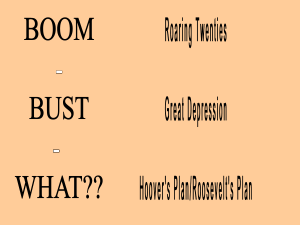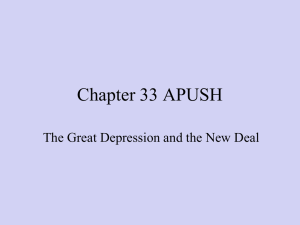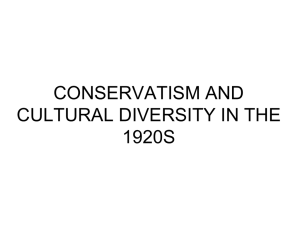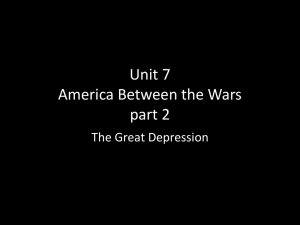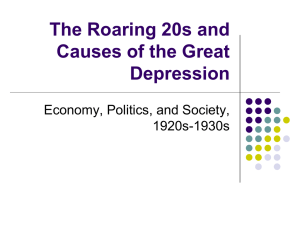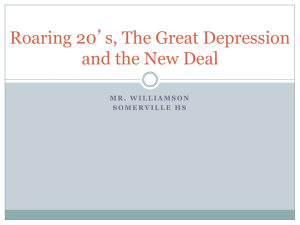American History Unit 5: Roaring 20s and Great Depression
advertisement
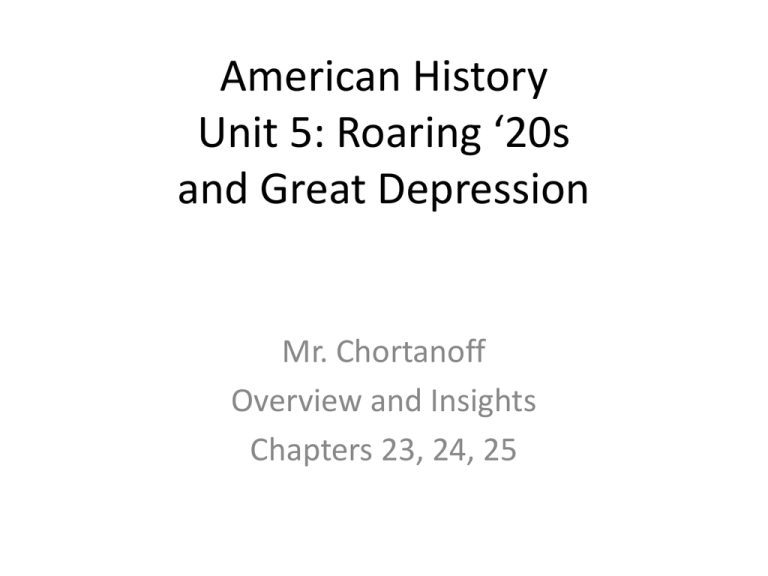
American History Unit 5: Roaring ‘20s and Great Depression Mr. Chortanoff Overview and Insights Chapters 23, 24, 25 Big Ideas: 1. The Roaring 1920s was a time of economic prosperity and opportunity as seen in significant political, economic, and cultural changes 2. The Great Depression was a time of desperation and a source of new political, economic, and cultural reform. Unit Essential Questions: 1. How would you describe the political, economic, and cultural changes during the Roaring ‘20s? 2. How would you explain the Great Depression as a time of desperation and a source of new political, economic, and cultural reform? 3 Concepts THE ROARING 1920s: AGE OF JAZZ AND POPULAR CULTURE THE GREAT DEPRESSION THE NEW DEAL, 1933-1939 1. How was America a world economic power after WWI? 1. How would you explain the causes of the Stock Market Crash of 1929 and the Great Depression? 1. How would you compare and contrast the leadership and policies of President Hoover and President FDR to combat the Great Depression? 2. What was the Age of Jazz and Popular Culture? 2. How would you summarize the nature of the Great Depression for the average American? 2. What was the effectiveness of the New Deal in the economic relief, recovery, and reform of America? 3. In what ways did American culture become popularized through a growing sense of consumerism? 3. What political, economic, and cultural changes took place during the Great Depression? 3. What was fascism and how did it threaten America’s isolationist views and policies? The Roaring 1920s: The Age of Prosperity and Jazz • Causes, Nature, Effects of this NEW WAY OF LIFE – American Post-WWI economic prosperity of rebuilding/feeding Europe. Profits grow, average income rises, stocks grow, peace – Republican Party’s Leadership (Harding , Coolidge, and Hoover) favored few gov’t regulations, ‘the business of America is business’ mentality of gov’t assisting businesses—not regulating them to prevent monopolies/abuse – Shift from a production of goods to a consumption of goods • Mass consumption of mass produced popular goods. • ‘Homogenization’ = Making everything (products) the same for everyone • Impact of Communication and Technology: – Clothing, Movies, Jazz Music, Dances, Attitudes/Values, Cars (travel is easier, faster, more common), Phones, Radio, Professional and Collegiate Sports, Syndicated Newspapers, Comics – ILLUSION: Such an ‘easy’ life and ‘strong’ economy led to a false belief in security. Americans also felt safe with the Atlantic and Pacific Oceans to protect them from European conflicts. They returned to ‘Isolationism ‘ • Changing roles for women • Earned respect during WWI in factories, business, and family farm. Women get the right to vote and feel empowered with money from jobs outside of the house, education opportunities, vote, run for office, work for Equal Rights Amendment (fails), more jobs/careers are open to women, they marry later in life, have fewer children, and use birth control to plan families. Many, but not all, are more independent • Some were Flappers who symbolized the new sense of freedom and independence for women – They were up on the latest fads and fashions like dance marathons, the Charleston dance craze, wore bobbed hair, short skirts, makeup, smoked cigarettes, drank alcohol, drove fast cars, • Jazz Age • New American Writers (Style) – E. Hemingway and F.S. Fitzgerald • Harlem Renaissance (AA Awareness) – Langston Hughes • An Age of Sports Heroes – Pro and Collegiate Sports Figures – “Lucky Lindy” (Charles Lindbergh) • Red Scare remains: – Fear of communists/strikes/immigrants/anarchists EX: SACCO & VANZETTI The Great Depression • Causes – Illusion of Prosperity and Bad Policies of the 1920s: • Post WWI Europe recovers, doesn’t need American goods and services. High protective tariffs slow international trade. • In America: – Widening gap between the rich and the poor. If the rich didn’t spend money, then the poor couldn’t get their hands on it via wages, salaries, or investment opportunities. Too much of the wealth in this nation was in the hands of a few people/businesses – Unregulated stock market speculation (buying on the margin—w/ credit) – Flawed banking system – Overproduction of goods / Farmers with BIG loans / production – Stock Market Crash of 1929 – President Herbert Hoover’s limited intervention to stave off disaster • Nature / Course – Significant impact on a generation of Americans • Officially from 1929 to 1941. Lasting impact on children. – Thousands of banks fail/close – Deflation and Millions of Americans lose life savings and investments – Countless businesses close – Widespread unemployment, homelessness, hunger – Hoover’s Administration takes a ‘hands off approach’ to allow ‘the market to fix itself’ instead of gov’t intervention – “Hoovervilles,” bread lines, drop in church attendance due to embarrassment, calls/protests for relief, reform, recovery – Bonus Army March of 1932 is dispersed with military force – FDR (Dem. Gov. NY) elected 4x (1932, ‘36, ‘40, ‘44) • FDR’s aggressive/socialist policies replace Hoover’s • WWII starts in Europe; America participates and joins Allies (vs. Axis) The Great Crash: October 1929 FDR: Characteristics • Pragmatist • An experimenter not set on one philosophy or theory of governance or economics • Man of action • Reassuring man with great confidence – Fire Side Chats, Inaugural Address: “The only thing we have to fear is…” • • • • • Persuasive Good-natured No excuses for success (not even Polio) Family Man / Role Model Willing to ‘push the limit’ of executive power to bring change to America and end the Great Depression – Massive legislation effort, Most vetoed bills, USSC declares much to be unconstitutional, Court-Packing Plan, – Limited response to rise of fascism/militarism in Europe and Japan as seen in flagrant disregard for the League of Nations. Couldn’t do much. FDR’s “New Deal”: 1933-1939: “I pledge to you, I pledge myself, to a new deal for the American people.”--FDR • Causes – Post WWI Economic Situation, Great Crash of 1929, Great Depression, Mandate from the people for change • Nature – Restored public confidence in gov’ts ability and concern for the American people – New Deal has 3 goals: • Relief for those people who were suffering • Recovery for the economy, so it could grow again • Reform measures to avoid future depressions • The New Deal was basically a massive federal legislation effort to create gov’t run social and economic programs to bring relief, recovery, and reform to the American people, gov’t, and businesses. • The tool: Congress and FDR passed much legislation ($) • The ‘alphabet soup’ of agencies + laws is as follows: – Relief • CCC, TVA, FERA, PWA, REA, WPA – Recovery • NIRA(ruled unconst.), HOLC, FHA, AAA (1st and 2nd) – reform • FDIC, SEC, SSA, Wagner Act, FLSA New Deal for Minorities and Women • Native Americans – Since getting citizenship in 1924, conditions improved during the 1930s. – Indian Reorganization Act/Wheeler-Howard Act passed to restore tribal self-government, languages, customs, religious freedoms, and $ for education (ended Dawes Act of forced assimilation on reservations) • African Americans – Not a good time to be an AA. They didn’t organize like the NAs – Lynchings increased during the 1930s, not because FDR approved but in part because he couldn’t anger or alienate the Southern Democrats (whites) in the South by ending the poll tax, speaking up for them, providing programs directly for AA, or supporting an anti-lynching law • Hispanic Americans – Not a good time, they were seen as competitors (already a surplus of labor) for jobs. If they were hired, then white Americans weren’t. – Migrant workers and illegal immigrants were sent back to Mexico, etc. • Female Americans – Women earned 50 cents to the man’s dollar for the same job – Traditional values return: Women are wives and mothers. Men work.
